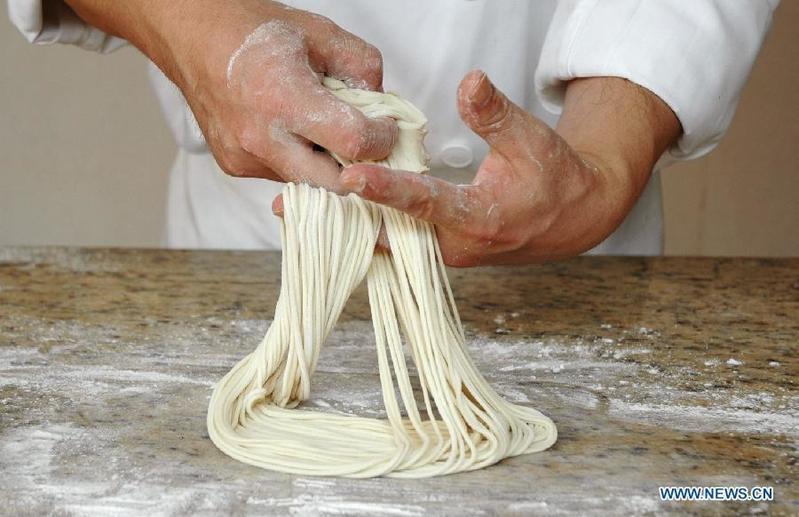 In this Jan 22, 2014 file photo, a cook tries to pull noodles at a noodle shop in Lanzhou, capital of northwest China's Guansu province. (PHOTO / XINHUA)
In this Jan 22, 2014 file photo, a cook tries to pull noodles at a noodle shop in Lanzhou, capital of northwest China's Guansu province. (PHOTO / XINHUA)
Residents of a remote county have literally pulled themselves out of poverty with lamian, or hand-pulled noodles.
We call Hualong lamian the noodle for poverty alleviation.
Ma Jianguo, deputy head of Hualong's bureau for local brand and industry promotion
A decade ago in Hualong, a county in Qinghai province, almost half of its 300,000-plus residents were living in poverty. Last year, the county eradicated poverty, with a majority of its residents having improved their lives through lamian.
"We call Hualong lamian the noodle for poverty alleviation," said Ma Jianguo, deputy head of the county's bureau for local brand and industry promotion.
Currently, Hualong natives run about 17,000 hand-pulled noodle restaurants-about a quarter of such restaurants-across the country. The annual output value of these restaurants has reached 10 billion yuan (US$1.5 billion) and a total of 110,000 local people are involved in the businesses, Ma added.
Hualong people opened their first lamian restaurant outside the county in 1988 in Xiamen, Fujian province. Seeing adults leaving Hualong with equipment and materials needed for making hand-pulled noodles is among Han Haiming's most unforgettable childhood memories.
"I still remember the time when one of my uncles was to start his journey out of town. He carried a big bag on his back full of seasonings for making lamian, many of which were not available in other regions," the 39-year-old recalled.
Han decided to follow the elder generation's footsteps in 2001 when he graduated from senior high school. That year, he traveled over 2,000 kilometers to Shanghai and became an apprentice in a lamian restaurant opened by one of his fellow townsman.
"I saw many of my fellow townspeople get rich by selling lamian noodles and buy good cars. I wanted to be one of them," he noted.
He opened his own lamian restaurant in Shanghai with money raised by his father and now runs five lamian restaurants in the Shaanxi provincial capital Xi'an, the Shandong provincial capital Jinan and Guilin in the Guangxi Zhuang autonomous region. Each restaurant can rake in as much as 600,000 yuan annually.
While Han embarked on selling lamian noodles alone, many of his poverty-stricken fellow townsmen became beneficiaries of the industry with help from the local government.
ALSO READ: Web sales bear financial fruit for 'mango beauty' in Guangxi
In 2016, the county government introduced an entrepreneurial initiative for poverty-stricken people to work as apprentices in lamian restaurants that sign cooperation agreements with the government. In addition to a minimum monthly salary of 3,000 yuan from the restaurants, they can receive a government subsidy of 5,000 yuan a year, Ma said.
He said these people could choose to continue to work in lamian restaurants the second year, making at least 5,000 yuan a month, or start their own business with a 50,000 yuan loan offered by the local government. They will be spared from paying interest on the loan for three years.
Since 2016, over 8,000 people from 2,600 households have emerged from poverty thanks to the initiative, he added.
More ambitious plans are being rolled out as the county aspires to prosperity. For example, construction of a lamian industrial park with a total investment of 1.3 billion yuan is ongoing, and part of it has gone into operation.
The industrial park consists of bases for planting rapeseed, raising cows and processing raw materials. It is expected to serve 2,000 lamian restaurants by the end of this year, up from the current 1,800, Ma said, adding that the restaurants will consume 1.2 billion yuan worth of beef, flour and seasonings annually.
"We plan to send local Qinghai products to our lamian restaurants to help promote coordinated development of local agricultural, industrial and service sectors," he said.
READ MORE: With e-commerce as boost, herbs enriching villagers
Han Jinlu was one of the first few Hualong people to start lamian restaurants in other regions. With money he made from selling lamian, he started Urban Oasis Ecological Development Co, which combines catering, entertainment and tourism, in Longhua in 2008.
Lamian now is not only the noodle that helped us get rid of poverty but also the noodle that is helping us achieve prosperity.
Han Jinlu, owner of lamian restaurants outside Hualong
With over 300 employees, the annual income of the company has reached 20 million yuan, the 60-year-old said.
"When I was young, the grain we harvested from our farm could only support my family for eight months. We would suffer hunger if we failed to make enough money for food by doing some odd jobs," he recalled, adding poverty forced him out of his hometown to sell lamian.
READ MORE: Noodle makers get whiff of export success
With all people in the county having been removed from the poverty-stricken list, he expects the lamian industry to contribute more to the county's development.
"Lamian now is not only the noodle that helped us get rid of poverty but also the noodle that is helping us achieve prosperity," he said.


